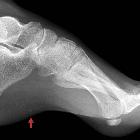Paralytic poliomyelitis
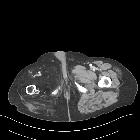
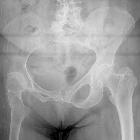
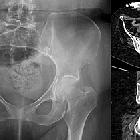





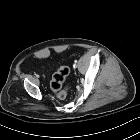


Poliomyelitis, more commonly known as just polio (and in the older literature, Heine-Medin disease), is a once common but now rare disease resulting from infection by the poliovirus. Most infected individuals develop no or non-serious symptoms as a result of the infection, but ~1% will develop life-altering disability (paralysis) due to the destruction of motor neurons.
Epidemiology
Although once a common disease worldwide, polio is now virtually non-existent in the Western hemisphere due to immunisation. Only 1,579 cases were confirmed in 2009 worldwide . The virus is most commonly spread via the fecal-oral route. However, oral-oral transmission is possible.
Clinical presentation
Two forms of poliomyelitis can occur after infection with poliovirus :
- non-paralytic poliomyelitis
- form of aseptic meningitis
- flu-like prodrome followed by muscular stiffness +/- paresthesia
- paralytic poliomyelitis
- biphasic illness with symptoms of non-septic meningitis, followed by a few days of being symptoms free then paralysis develops
- lower limbs more often affected than upper limbs
Radiographic features
Plain radiograph and CT
With acute infection, no radiographic features are typically evident.
Chronically, findings are characterized by atrophy of involved areas, including bone and muscle, which may be similar to other neuromuscular disorders. The extent of fatty muscle atrophy and/or bone atrophy may be striking. Often there are associated deformities due to involved muscles, most commonly flexion, abduction and external rotation at hip joint.
MRI
Neuroimaging may reveal ALS-like abnormalities in the affected areas of the ventral motor tracts in the spine and/or motor cortex, which are characteristically hyperintense on T2 WI .
Extensive fatty muscle atrophy may be seen in affected areas of the musculoskeletal system, which may be unilateral or bilateral.
Treatment and prognosis
In the modern Western world, poliomyelitis is prevented by vaccination. As no cure for poliomyelitis itself is available, treatment is supportive and designed to prevent complications and a quick recovery. Antibiotics are given to prevent infection of weakened muscles. Often an extended period of rehabilitation is necessary to regain full function of affected body parts .
Prognosis depends on the extent of motor neuron destruction by the time treatment is started and varies from complete recovery to severely debilitating paralysis .
History and etymology
"Poliomyelitis" derives from the Ancient Greek πολιός ("grey") and μνελός ("marrow"), indicating how the disease affects the spinal cord grey matter. Jacob von Heine (1800-1879), a German orthopedic surgeon, first described it in 1840 and the epidemic form was described by a Swedish pediatrician Karl Oskar Medin (1847-1914) in 1890 . Hence, it is sometimes known as Heine-Medin disease .
Differential diagnosis
- polio-like paralysis
- amyotrophic lateral sclerosis (ALS)
Siehe auch:

 Assoziationen und Differentialdiagnosen zu Poliomyelitis:
Assoziationen und Differentialdiagnosen zu Poliomyelitis:


